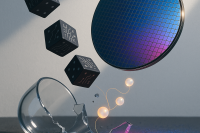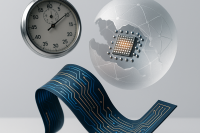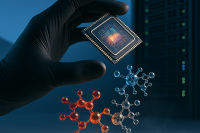Quantum Error Correction Advances Push Fault-Tolerant Computing Toward Reality
Published Nov 16, 2025
Between 2025-11-02 and 2025-11-12 the quantum computing field reported multiple QEC advances: DARPA selected QuEra and IBM for Stage B of its Quantum Benchmarking Initiative on 2025-11-06, awarding up to US$15 million over 12 months each to validate paths toward fault-tolerant systems with QBI targeting “computational value exceeds cost” by 2033; Princeton on 2025-11-05 demonstrated a tantalum-on-silicon superconducting qubit with coherence >1 ms (≈3× prior lab best, ≈15× industry standard); ECCentric published on 2025-11-02 benchmarking code families and finding connectivity more important than code distance; BTQ/Macquarie published an LDPC/shared-cavity QEC method; IBM revealed its Loon chip on 2025-11-12 and expects Nighthawk by end-2025 with possible task-level quantum advantage by late-2026. These developments lower error-correction overhead, emphasize hardware–code co-design, and point to near-term validation steps: QBI Stage C, public Loon/Nighthawk metrics, and verification of logical-qubit lifetimes.
DARPA’s QBI Sets 2033 Deadline for Utility-Scale, Fault-Tolerant Quantum
Published Nov 16, 2025
On 2025-11-06 DARPA advanced QuEra Computing and IBM to Stage B of its Quantum Benchmarking Initiative (QBI); QuEra’s award includes up to $15 million over 12 months to validate its neutral‐atom R&D toward utility‐scale, fault‐tolerant quantum computing. QBI sets a firm yardstick—confirming “computational value exceeds cost” by 2033—and moves teams from the six‐month Stage A assessment to a Stage B requirement for full R&D roadmaps, risk mitigation, scalability proofs and measurable hardware progress. Immediate next steps: QuEra, IBM (and candidates for Stage C) must deliver validation materials and demonstrate path to logical qubits and error‐correction scaling; independent third‐party verification is planned later. Impact: tighter hardware roadmaps, shifted investment toward Stage B performers, greater emphasis on fault tolerance and supply/talent constraints. Separately, UNESCO’s global neural‐data standards enter into force on 2025-11-12.
DARPA's QBI Pushes Quantum Fault-Tolerance Toward Utility-Scale by 2033
Published Nov 16, 2025
In the past two weeks DARPA’s Quantum Benchmarking Initiative advanced multiple firms into Stage B: on 2025-11-06 Quantinuum (its Lumos system, with a roadmap to a fault‐tolerant “Apollo” by 2029), IBM (advancing with R&D plans targeting large‐scale fault tolerance by 2033), and Silicon Quantum Computing (SQC) were selected for a year‐long, performance‐based evaluation to validate designs, error correction and scalability. Stage B requires detailed hardware, error‐correction and end‐to‐end system blueprints and effectively crystallizes a timeline toward “utility‐scale” quantum systems by 2033, driving hardware investment, validation tooling, government funding priorities and enterprise planning for early‐2030s use. Immediate next steps are the Stage B evaluations, publication of verifiable technical metrics, and monitoring additional Stage B awardees and prototype trials as key indicators of progress.
China's Ban on Foreign AI Chips Threatens Global Hardware Ecosystem
Published Nov 16, 2025
On 2025-11-05 Reuters reported that China issued guidance requiring state‐funded data centres under construction to use only domestically produced AI chips, forcing projects under 30% completion to remove foreign chips and subjecting more mature builds to case‐by‐case review; foreign suppliers named include Nvidia, AMD and Intel and even advanced Nvidia parts (H20, B200, H200) are barred. The directive aims to cut reliance on foreign hardware amid U.S. export controls and fast‐tracks market share to domestic vendors such as Huawei, Cambricon, MetaX and Moore Threads; Reuters cites Nvidia’s share in China falling from ~95% in 2022 to zero under the move and reports suspended projects. Expect technical risks (immature software stacks, supply disruptions), geopolitical tension and supply‐chain realignment; monitor formal rules late 2025–early 2026, capacity ramps 2025–2027, project delays in the next six months and foreign or allied responses through 2026.
Quantum Leap: Millisecond Qubits, Helios, and DARPA's Benchmarking Push
Published Nov 12, 2025
In early November 2025 three coordinated advances shifted the quantum-computing landscape: on Nov 5 Princeton reported 2D transmon qubits with coherence >1 millisecond and 99.994% single-qubit fidelity using tantalum on high-resistivity silicon; on Nov 5 Quantinuum unveiled Helios, a 98‐qubit ion‐trap system with a 2:1 physical-to-logical ratio (48 logical qubits), 99.9975% single‐qubit fidelity and 99.921% two‐qubit fidelity, available via cloud and slated for installation in Singapore in 2026 alongside a new Python-embedded language for real‐time error correction; and on Nov 7 DARPA advanced 11 companies to Stage B of its Quantum Benchmarking Initiative (targeting utility-scale operation by 2033), including QuEra which may receive up to $15M for a 12‐month R&D plan. Together these developments make practical quantum error correction and scaling materially more achievable; Stage B work and Helios deployments are the immediate next steps.
Verifiable Quantum Advantage: Google's Willow and IBM's FPGA Error-Correction Breakthrough
Published Nov 12, 2025
On 2025-10-22 Google and IBM announced complementary quantum milestones that move the field toward practical use: Google’s 105-qubit Willow processor ran the new Quantum Echoes OTOC algorithm, producing verifiable expectation values (including NMR-inferred geometries for 15- and 28-atom molecules) and executing 13,000× faster than the best classical algorithm, while Willow reported single-qubit fidelity ~99.97%, entangling gates ~99.88% and readout ~99.5%; IBM demonstrated a quantum error‐correction routine running in real time on conventional AMD FPGAs at 10× the required speed, advancing its Starling roadmap toward 2029. These results matter because verifiability and faster, FPGA-enabled error correction make real applications (molecular modeling, materials, drug discovery) more plausible; next steps are scaling to logical qubits, external replication of Quantum Echoes and error‐correction results, and broader industry benchmarks, with Google projecting useful applications within five years.





